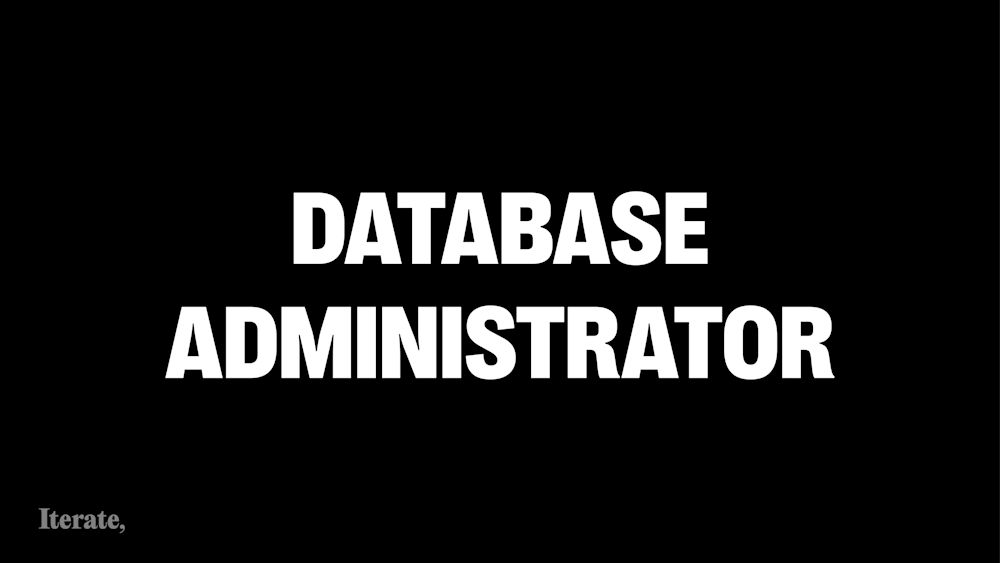Table of contents
Discover the role of database administrators and learn what their daily tasks look like, what the job requirements typically are, and how to hire the best in the field.

What is a Database Administrator
A database administrator, commonly referred to as a DBA, is a skilled IT professional responsible for the design, implementation, maintenance, and security of an organization's database systems. DBAs ensure that databases are efficiently managed, optimized for performance, and available for use by authorized users. They work with various database management systems (DBMS), such as Oracle and Microsoft SQL to create and manage databases and more. Ultimately, they play a critical role in ensuring the reliability, availability, and security of an organization's data, making them an essential part of IT operations.
If you are looking for a job as an database administrator you can check out the open positions below.
How Much Does a Database Administrator Make?
On average, the salary of a database administrator (DBA) varies depending on factors such as location, level of experience, industry, and the like. According to data from reputable sources such as Glassdoor, as of 2023, the average annual salary for a DBA in the United States is $79,194. Entry-level DBAs with minimal experience may earn around $70,000 to $80,000, while those with more experience and expertise can earn upwards of $100,000 or more. In terms of the highest annual salaries, those exist primarily in the healthcare industry.
- City National Bank - $139,642
- Fidelity TalentSource - $135,036
- Zachary Piper Solutions - $132,778
What are the Job Responsibilities of a Database Administrator?
The job responsibilities of a database administrator can vary by industry. However, they typically consist of the following.
- Designing, implementing, and maintaining the organization's database architecture.
- Ensuring data integrity and security, optimizing database performance, and troubleshooting and resolving database issues.
- Creating and managing user accounts, granting and revoking access permissions, and monitoring database usage and performance.
- Performing backups and recovery procedures to ensure data availability and integrity.
- Collaborating with other IT professionals, such as developers and network administrators, to integrate database systems with other applications and systems, and provide support and guidance on database-related matters to stakeholders across the organization.
Ultimately, one’s role is critical in ensuring the smooth and efficient functioning of an organization's database systems, which are vital for storing and managing critical business data.
Meeting a Database Administrator
It’s one thing to know the requirements of a role — it’s another to see yourself in it. At The Org, we believe that putting faces to the job title can provide more context and a better sense of how the role fits into the big picture.
Explore live positions for database administrators and meet the people behind the title here.
Tips for Recruiting Top Database Administrator Talent
If you feel you’re ready to begin recruiting a new database administrator, the following tips will undoubtedly prove valuable.
- **Understand what their day-to-day looks like. **To be efficient in your recruiting efforts, you must first understand what they actually do on a daily basis. That way, you’ll be able not only to create an effective job description but also to properly assess candidate abilities.
- **Focus on the must-have skills. **You already know what skills are needed to execute this position successfully, but which ones won’t you budge on? Make sure to include these must-have skills in your job description to attract relevant talent.
- **Prioritize high level analytical skills. **Otherwise, you could find yourself attracting talent that lacks the analytical skills to troubleshoot the bounty of problems that frequently arise.
- **Know the difference between a data and database administrator. **Like we mentioned in tip #1, understanding this role is crucial for recruiting success. And while these positions sound similar in nature, database administrators are responsible for managing, maintaining, and securing data.
By implementing the following tips into your recruiting process, you can successfully pull an array of talented candidates.
At The Org, we believe traditional recruiting needs a refresh. Candidates want to know who they’ll work with, not just what they’ll do. Workplace culture, interpersonal relationships, and company values are more important now than ever.
And what better way to showcase your company’s unique culture than through your Org Chart?
Highlight different teams in your organization, the people that make these teams great, and show candidates how they fit into the big picture.
Your Org Chart is a novel and effective way to show candidates where they fit in and to show off your greatest asset: your people.
Explore Org Charts here, and sign up today to create your own customized Org Chart for your company.


The ORG helps
you hire great
candidates
Free to use – try today